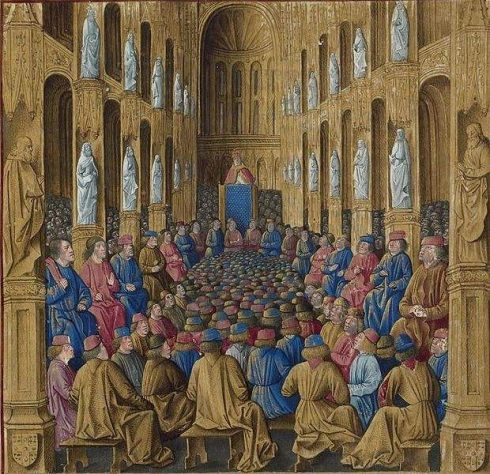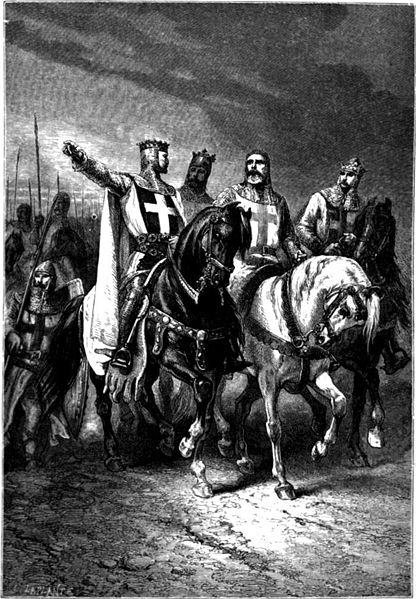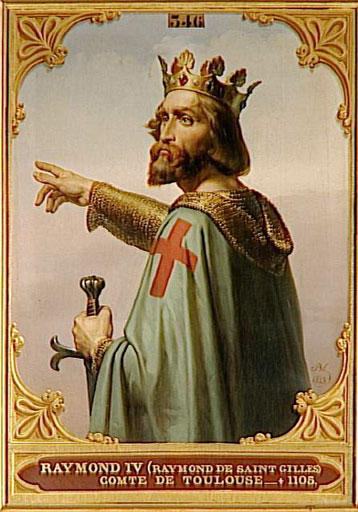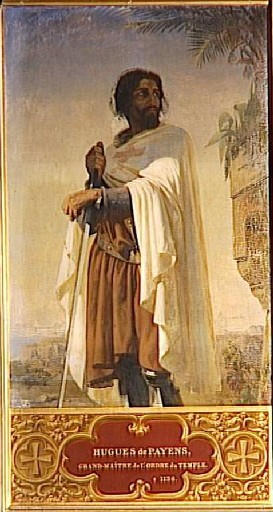II. FOUNDATION OF CHRISTIAN STATES IN THE EAST
After travelling through Burgundy and the south of France, Urban II convoked a council at Clermont-Ferrand, in Auvergne. It was attended by fourteen archbishops, 250 bishops, and 400 abbots; moreover a great number of knights and men of all conditions came and encamped on the plain of Chantoin, to the east of Clermont, 18-28 November, 1095. On 27 November, the pope himself addressed the assembled multitudes, exhorting them to go forth and rescue the Holy Sepulchre. Amid wonderful enthusiasm and cries of “God wills it!” all rushed towards the pontiff to pledge themselves by vow to depart for the Holy Land and receive the cross of red material to be worn on the shoulder. At the same time the pope sent letters to all Christian nations, and the movement made rapid headway throughout Europe.
Preachers of the crusade appeared everywhere, and on all sides sprang up disorganized, undisciplined, penniless hordes, almost destitute of equipment, who, surging eastward through the valley of the Danube, plundered as they went along and murdered the Jews in the German cities. One of these bands, headed by Folkmar, a German cleric, was slaughtered by the Hungarians. Peter the Hermit, however, and the German knight, Walter the Pennyless (Gautier Sans Avoir), finally reached Constantinople with their disorganized troops. To save the city from plunder Alexius Comnenus ordered them to be conveyed across the Bosporus (August, 1096); in Asia Minor they turned to pillage and were nearly all slain by the Turks. Meanwhile the regular crusade was being organized in the West and, according to a well-conceived plan, the four principal armies were to meet at Constantinople.
- Godfrey of Bouillon, Duke of Lower Lorraine at the head of the people of Lorraine, the Germans, and the French from the north, followed the valley of the Danube, crossed Hungary, and arrived at Constantinople, 23 December, 1096.
- Hugh of Vermandois, brother of King Philip I of France, Robert Courte-Heuse, Duke of Normandy, and Count Stephen of Blois, led bands of French and Normans across the Alps and set sail from the ports of Apulia for Dyrrachium (Durazzo), whence they took the “Via Egnatia” to Constantinople and assembled there in May, 1097.
- The French from the south, under the leadership of Raymond of Saint-Gilles, Count of Toulouse, and of Adhemar of Monteil, Bishop of Puy and papal legate, began to fight their way through the longitudinal valleys of the Eastern Alps and, after bloody conflicts with the Slavonians, reached Constantinople at the end of April, 1097.
- Lastly, the Normans of Southern Italy, won over by the enthusiasm of the bands of crusaders that passed through their country, embarked for Epirus under the command of Bohemond and Tancred, one being the eldest son, the other the nephew, of Robert Guiscard. Crossing the Byzantine Empire, they succeeded in reaching Constantinople, 26 April, 1097.
The appearance of the crusading armies at Constantinople raised the greatest trouble, and helped to bring about in the future irremediable misunderstandings between the Greeks and the Latin Christians. The unsolicited invasion of the latter alarmed Alexius, who tried to prevent the concentration of all these forces at Constantinople by transporting to Asia Minor each Western army in the order of its arrival; moreover, he endeavoured to extort from the leaders of the crusade a promise that they would restore to the Greek Empire the lands they were about to conquer. After resisting the imperial entreaties throughout the winter, Godfrey of Bouillon, hemmed in at Pera, at length consented to take the oath of fealty. Bohemond, Robert Courte-Heuse, Stephen of Blois, and the other crusading chiefs unhesitatingly assumed the same obligation; Raymond of St-Gilles, however, remained obdurate.
Transported into Asia Minor, the crusaders laid siege to the city of Nicæa, but Alexius negotiated with the Turks, had the city delivered to him, and prohibited the crusaders from entering it (1 June, 1097). After their victory over the Turks at the battle of Dorylæum on 1 July, 1097, the Christians entered upon the high plateaux of Asia Minor. Constantly harrassed by a relentless enemy, overcome by the excessive heat, and sinking under the weight of their leathern armour covered with iron scales, their sufferings were wellnigh intolerable. In September, 1097, Tancred and Baldwin, brothers of Godfrey of Bouillon, left the bulk of the army and entered Armenian territory. At Tarsus a feud almost broke out between them, but fortunately they became reconciled. Tancred took possession of the towns of Cilicia, whilst Baldwin, summoned by the Armenians, crossed the Euphrates in October, 1097, and, after marrying an Armenian princess, was proclaimed Lord of Edessa.
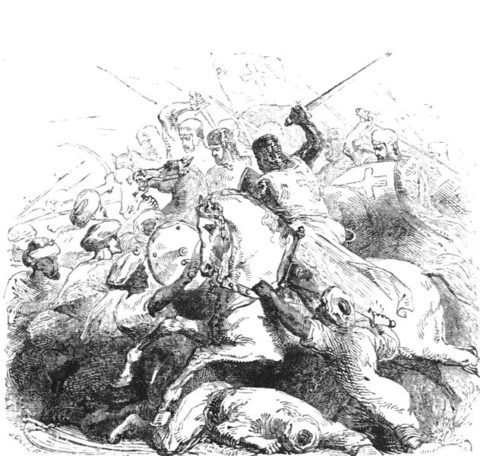 Meanwhile the crusaders, revictualled by the Armenians of the Taurus region, made their way into Syria and on 20 October, 1097, reached the fortified city of Antioch, which was protected by a wall flanked with 450 towers, stocked by the Ameer Jagi-Sian with immense quantities of provisions. Thanks to the assistance of carpenters and engineers who belonged to a Genoese fleet that had arrived at the mouth of the Orontes, the crusaders were enabled to construct battering-machines and to begin the siege of the city. Eventually Bohemond negotiated with a Turkish chief who surrendered one of the towers, and on the night of 2 June, 1098, the crusaders took Antioch by storm. The very next day they were in turn besieged within the city by the army of Kerbûga, Ameer of Mosul. Plague and famine cruelly decimated their ranks, and many of them, among others Stephen of Blois, escaped under cover of night. The army was on the verge of giving way to discouragement when its spirits were suddenly revived by the discovery of the Holy Lance, resulting from the dream of a Provençal priest named Pierre Barthélemy. On 28 June, 1098, Kerbûga’s army was effectually repulsed, but, instead of marching on Jerusalem without delay, the chiefs spent several months in a quarrel due to the rivalry of Raymond of Saint-Gilles and Bohemond, both of whom claimed the right to Antioch. It was not until April, 1099, that the march towards Jerusalem was begun, Bohemond remaining in possession of Antioch while Raymond seized on Tripoli. On 7 June the crusaders began the siege of Jerusalem. Their predicament would have been serious, indeed, had not another Genoese fleet arrived at Jaffa and, as at Antioch, furnished the engineers necessary for a siege.
Meanwhile the crusaders, revictualled by the Armenians of the Taurus region, made their way into Syria and on 20 October, 1097, reached the fortified city of Antioch, which was protected by a wall flanked with 450 towers, stocked by the Ameer Jagi-Sian with immense quantities of provisions. Thanks to the assistance of carpenters and engineers who belonged to a Genoese fleet that had arrived at the mouth of the Orontes, the crusaders were enabled to construct battering-machines and to begin the siege of the city. Eventually Bohemond negotiated with a Turkish chief who surrendered one of the towers, and on the night of 2 June, 1098, the crusaders took Antioch by storm. The very next day they were in turn besieged within the city by the army of Kerbûga, Ameer of Mosul. Plague and famine cruelly decimated their ranks, and many of them, among others Stephen of Blois, escaped under cover of night. The army was on the verge of giving way to discouragement when its spirits were suddenly revived by the discovery of the Holy Lance, resulting from the dream of a Provençal priest named Pierre Barthélemy. On 28 June, 1098, Kerbûga’s army was effectually repulsed, but, instead of marching on Jerusalem without delay, the chiefs spent several months in a quarrel due to the rivalry of Raymond of Saint-Gilles and Bohemond, both of whom claimed the right to Antioch. It was not until April, 1099, that the march towards Jerusalem was begun, Bohemond remaining in possession of Antioch while Raymond seized on Tripoli. On 7 June the crusaders began the siege of Jerusalem. Their predicament would have been serious, indeed, had not another Genoese fleet arrived at Jaffa and, as at Antioch, furnished the engineers necessary for a siege.
After a general procession which the crusaders made barefooted around the city walls amid the insults and incantations of Mohammedan sorcerers, the attack began 14 July, 1099. Next day the Christians entered Jerusalem from all sides and slew its inhabitants regardless of age or sex. Having accomplished their pilgrimage to the Holy Sepulchre, the knights chose as lord of the new conquest Godfrey of Bouillon, who called himself “Defender of the Holy Sepulchre”. They had then to repulse an Egyptian army, which was defeated at Ascalon, 12 August, 1099. Their position was nevertheless very insecure. Alexius Comnenus threatened the principality of Antioch, and in 1100 Bohemond himself was made prisoner by the Turks, while most of the cities on the coast were still under Mohammedan control. Before his death, 29 July, 1099, Urban II once more proclaimed the crusade. In 1101 three expeditions crossed Europe under the leadership of Count Stephen of Blois, Duke William IX of Aquitaine, and Welf IV, Duke of Bavaria. All three managed to reach Asia Minor, but were massacred by the Turks. On his release from prison Bohemond attacked the Byzantine Empire, but was surrounded by the imperial army and forced to acknowledge himself the vassal of Alexius. On Bohemond’s death, however, in 1111, Tancred refused to live up to the treaty and retained Antioch. Godfrey of Bouillon died at Jerusalem 18 July, 1100. His brother and successor, Baldwin of Edessa, was crowned King of Jerusalem in the Basilica of Bethlehem, 25 December, 1100. In 1112, with the aid of Norwegians under Sigurd Jorsalafari and the support of Genoese, Pisan, and Venetian fleets, Baldwin I began the conquest of the ports of Syria, which was completed in 1124 by the capture of Tyre. Ascalon alone kept an Egyptian garrison until 1153.
At this period the Christian states formed an extensive and unbroken territory between the Euphrates and the Egyptian frontier, and included four almost independent principalities: the Kingdom of Jerusalem, the Countship of Tripoli, the Principality of Antioch, and the Countship of Rohez (Edessa). These small states were, so to speak, the common property of all Christendom and, as such, were subordinate to the authority of the pope. Moreover, the French knights and Italian merchants established in the newly conquered cities soon gained the upper hand. The authority of the sovereigns of these different principalities was restricted by the fief-holders, vassals, and under-vassals who constituted the Court of Lieges, or Supreme Court. This assembly had entire control in legislative matters; no statute or law could be established without its consent; no baron could be deprived of his fief without its decision; its jurisdiction extended over all, even the king, and it controlled also the succession to the throne. A “Court of the Burgesses” had similar jurisdiction over the citizens. Each fief had a like tribunal composed of knights and citizens, and in the ports there were police and mercantile courts. The authority of the Church also helped to limit the power of the king; the four metropolitan sees of Tyre, Cæsarea, Bessan, and Petra were subject to the Patriarch of Jerusalem, similarly seven suffragan sees and a great many abbeys, among them Mount Sion, Mount Olivet, the Temple, Josaphat, and the Holy Sepulchre. Through rich and frequent donations the clergy became the largest property-holders in the kingdom; they also received from the crusaders important estates situated in Europe.
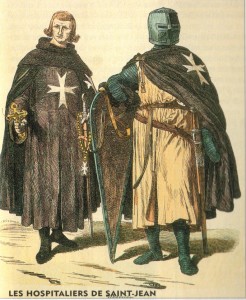 In spite of the aforesaid restrictions, in the twelfth century the King of Jerusalem had a large income. The customs duties established in the ports and administered by natives, the tolls exacted from caravans, and the monopoly of certain industries were a fruitful source of revenue. From a military point of view all vassals owed the king unlimited service as to time, though he was obliged to compensate them, but to fill the ranks of the army it was necessary to enroll natives who received a life annuity (fief de soudée). In this way was recruited the light cavalry of the “Turcoples”, armed in Saracenic style. Altogether these forces barely exceeded 20,000 men, and yet the powerful vassals who commanded them were almost independent of the king. So it was that the great need of regular troops for the defence of the Christian dominions brought about the creation of a unique institution, the religious orders of knighthood, viz.: the Hospitallers, who at first did duty in the Hospital of St. John founded by the aforesaid merchants of Amalfi, and were then organized into a militia by Gérard du Puy that they might fight the Saracens (1113); and the Templars, nine of whom in 1118 gathered around Hugues de Payens and received the Rule of St. Bernard. These members, whether knights drawn from the nobility, bailiffs, clerks, or chaplains, pronounced the three monastic vows but it was chiefly to the war against the Saracens that they pledged themselves.
In spite of the aforesaid restrictions, in the twelfth century the King of Jerusalem had a large income. The customs duties established in the ports and administered by natives, the tolls exacted from caravans, and the monopoly of certain industries were a fruitful source of revenue. From a military point of view all vassals owed the king unlimited service as to time, though he was obliged to compensate them, but to fill the ranks of the army it was necessary to enroll natives who received a life annuity (fief de soudée). In this way was recruited the light cavalry of the “Turcoples”, armed in Saracenic style. Altogether these forces barely exceeded 20,000 men, and yet the powerful vassals who commanded them were almost independent of the king. So it was that the great need of regular troops for the defence of the Christian dominions brought about the creation of a unique institution, the religious orders of knighthood, viz.: the Hospitallers, who at first did duty in the Hospital of St. John founded by the aforesaid merchants of Amalfi, and were then organized into a militia by Gérard du Puy that they might fight the Saracens (1113); and the Templars, nine of whom in 1118 gathered around Hugues de Payens and received the Rule of St. Bernard. These members, whether knights drawn from the nobility, bailiffs, clerks, or chaplains, pronounced the three monastic vows but it was chiefly to the war against the Saracens that they pledged themselves.
Being favoured with many spiritual and temporal privileges, they easily gained recruits from among the younger sons of feudal houses and acquired both in Palestine and in Europe considerable property. Their castles, built at the principal strategic points, Margat, Le Crac, and Tortosa, were strong citadels protected by several concentric enclosures. In the Kingdom of Jerusalem these military orders virtually formed two independent commonwealths. Finally, in the cities, the public power was divided between the native citizens and the Italian colonists, Genoese, Venetians, Pisans, and also the Marseillais who, in exchange for their services, were given supreme power in certain districts wherein small self-governing communities had their consuls, their churches, and on the outskirts their farm-land, used for the cultivation of cotton and sugar-cane. The Syrian ports were regularly visited by Italian fleets which obtained there the spices and silks brought by caravans from the Far East. Thus, during the first half of the twelfth century the Christian states of the East were completely organized, and even eclipsed in wealth and prosperity most of the Western states.
[to be continued]LOUIS BRÉHIER (Catholic Encyclopedia)
II. Foundation of Christian states in the East;
